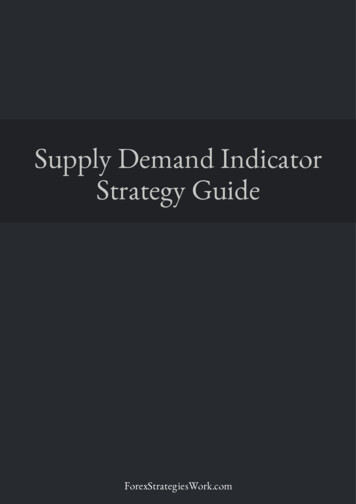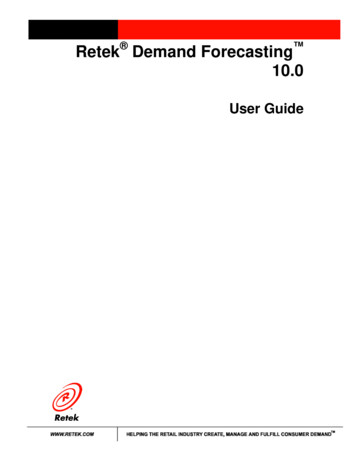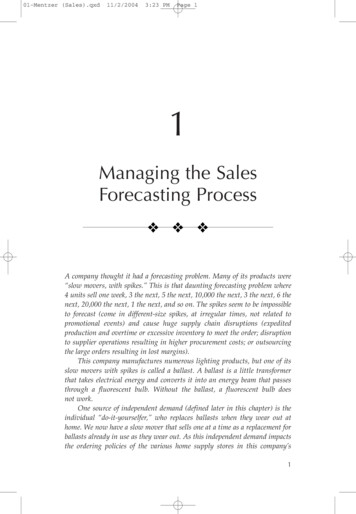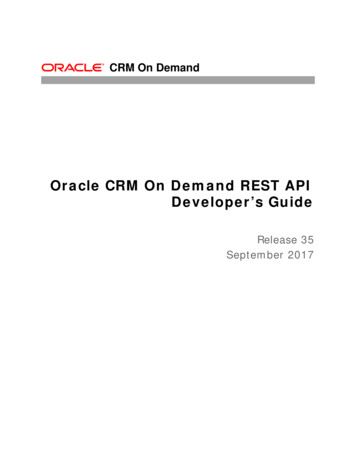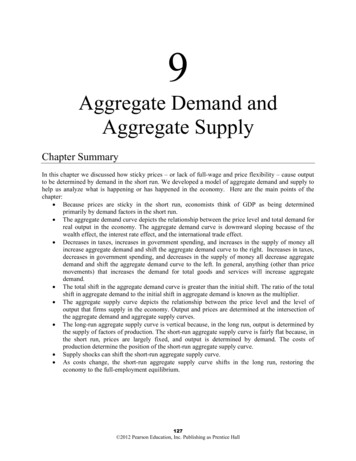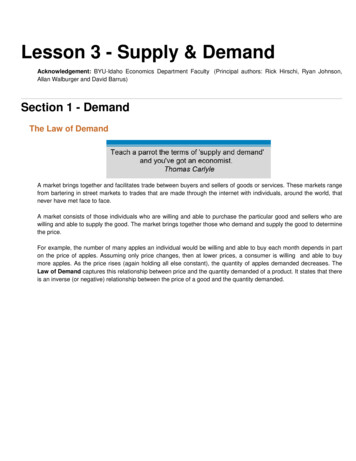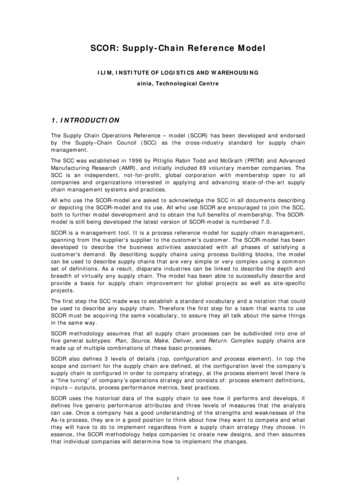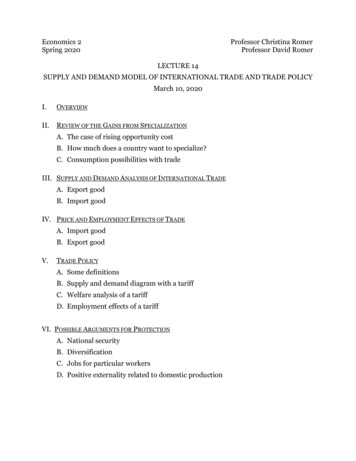
Transcription
Economics 2Spring 2020Professor Christina RomerProfessor David RomerLECTURE 14SUPPLY AND DEMAND MODEL OF INTERNATIONAL TRADE AND TRADE POLICYMarch 10, 2020I.OVERVIEWII.REVIEW OF THE GAINS FROM SPECIALIZATIONA. The case of rising opportunity costB. How much does a country want to specialize?C. Consumption possibilities with tradeIII. SUPPLY AND DEMAND ANALYSIS OF INTERNATIONAL TRADEA. Export goodB. Import goodIV. PRICE AND EMPLOYMENT EFFECTS OF TRADEA. Import goodB. Export goodV.TRADE POLICYA. Some definitionsB. Supply and demand diagram with a tariffC. Welfare analysis of a tariffD. Employment effects of a tariffVI. POSSIBLE ARGUMENTS FOR PROTECTIONA. National securityB. DiversificationC. Jobs for particular workersD. Positive externality related to domestic production
Economics 2Spring 2020Christina RomerDavid RomerLECTURE 14Supply and Demand Model of InternationalTrade and Trade PolicyMarch 10, 2020
Announcements Course capture of lecture is available on CalCentral(under “My Academics”) or on the Econ 2bCourses page (under “Course Captures”). Section will meet via Zoom. Your GSI will email youwith instructions. Problem Set 3 is to be submitted electronicallythrough Gradescope. (Details on how to do it weresent in an email yesterday.) Office hours will be via Zoom.
Announcements (Continued) Please keep up! You will need to be working just as hard as before(if not harder). We will likely be changing problem set frequencyto nudge you in that direction.
I. OVERVIEW
Topics Supply and demand framework with internationaltrade. Price and employment effects of trade. How does a country go about limiting trade? Are there good reasons for limiting trade?
II. REVIEW OF THE GAINS FROM SPECIALIZATION
Example Suppose the U.S. makes two goods (soybeans andwashing machines). Assume that the PPC for the U.S. is curved (thereis rising opportunity cost).
Optimal Specialization when the PPC is CurvedWashingMachines(WM)U.S. PPCSoybeans (S)
Example (continued) Assume the world price of soybeans is 400 andthe world price of washing machines is 300 (inthe same currency), so the terms of trade is 1⅓washing machines per 1 ton of soybeans. Another name for the terms of trade is the worldrelative price (Psoybeans /PWashing Machines).
Optimal Specialization when the PPC is CurvedWashingMachines(WM)(Slope (minus) WM per 1 S;in our example it is 1⅓)CPCU.S. PPC Pointof TangencySoybeans(S)
Consumption Possibilities Curve with Trade Graphically, it is a line with slope (minus) theterms of trade (expressed as per 1 of the good onthe horizontal axis) that is just tangent to the PPC. Intuitively, it shows the combinations of the twogoods that the country can consume if it makesthe bundle at the point of tangency and thentrades at world prices.
III. SUPPLY AND DEMAND MODEL OFINTERNATIONAL TRADE
Some Notes on the Interpretation of theSupply and Demand Diagram with Trade The U.S. supply curve is upward sloping to reflectthe notion of rising opportunity cost (the curvedPPC). The world price is the world relative price: The price in a supply and demand diagram isalways the price relative to other prices in theeconomy. We assume that the world demand and worldsupply at that world relative price is perfectly elastic.
Supply and Demand Diagram for an Export GoodPSUSPWorldP1USWorld Price with TradeU.S. Price without TradeDUSUSUSQQQUS1SDExportsQ
Supply and Demand Diagram for an Import GoodPP1USSUSU.S. Price without TradePWorldWorld Price with TradeDUSUSUSQQQUS1DSImportsQ
Supply and Demand Diagram with TradeShows Some Useful Points With rising opportunity cost, we get incompletespecialization. The intersection between the world price line andSUS corresponds to the point of tangency in thePPC/CPC diagram. The intersection between the world price line andDUS shows the point we choose on our CPC.
IV. PRICE AND EMPLOYMENT EFFECTS OF TRADE
Supply and Demand Diagram for an Import GoodPP1USSUSU.S. Price without TradePWorldWorld Price with TradeDUSUSUSQQQUS1DSQ
U.S. Price Index for All Goods and AppliancesAll Consumer GoodsMajor AppliancesSource: FRED, Federal Reserve Bank of St. Louis.
Effect of Increased TradeMarket for Workers in an Import IndustryWS1The labor demand curve is theMRPL. The world price is lowerthan the price in the US withouttrade. This is why the labordemand curve shifts down foran import good.W1W2D2 D1L2 L1LD1 is labor demand before the increase in trade; D2 is labor demand after the trade increase.
Supply and Demand Diagram for an Export GoodPSUSPWorldP1USWorld Price with TradeU.S. Price without TradeDUSUSUSQQQUS1SDQ
Effect of Increased TradeMarket for Workers in an Export IndustryWS1The labor demand curve is theMRPL. The world price is higherthan the price in the US withouttrade. This is why the labordemand curve shifts up for anexport good.W2W1D2D1L1 L2LD1 is labor demand before the increase in trade; D2 is labor demand after the trade increase.
Employment Effects of Trade Trade tends to rearrange jobs, rather than raise orlower employment overall. Employment expands in export industriesand contracts in import industries. But, the rearrangement can be very painful forworkers who lose their jobs (and who may nothave the skills needed to move to the industrieswhere jobs are available).
V. TRADE POLICY
Some Definitions Free trade: A country puts no barriers tointernational trade. Protection: A country puts limits on trade. Trade policy: A country’s policies toward trade.
Trade Policy is Not the Only Determinant ofTrade Shipping costs matter. Improved logistics can make trade easier. Better communication makes trade in servicespossible.
The Advent of the Container Ship
Methods of Protection Tariff: A tax on imports. Quota: A limit on the quantity of imports. Subsidies for domestic production.
Average U.S. Tariff Rates on Dutiable Imports
PEffects of a TariffSUSPWorld tariffPWorldDUSUS QUS USQQUSD2 QD1S2S1Imports before TariffImports after TariffQ
Welfare Analysis of a TariffPSUSabPWorld tariffPWorldcdefgDUSConsumer SurplusProducer SurplusTariff RevenueTotal SurplusDeadweight LossUS QUS USQQUSD2 QD1S2S1USBefore Tariff(QUSS1 , QD1 )a b c d e fga b c d e f gQUSAfter Tariff(QUSD2 , QS2 )a bc gea b c e gd f
Percent Change in Washing Machine PricesSource: The New York Times, January 25, 2019.
Employment Effects of a Tariff It likely raises employment in the protectedindustry. But, it does not raise overall employment. Because of retaliation and inducedmovements in the exchange rate. There may also be unintended effects on workersin other industries.
Source: Peterson Institute for International Economics, February 14, 2020.
VI. POSSIBLE ARGUMENTS FOR PROTECTION
Possible Arguments for Protection National security Diversification Infant industry/dynamic comparative advantage Jobs for particular workers Positive externalities
Positive Externality of Production and a TariffPSUSaPWorld tariffPWorldbcSMBUSDUS, PMBUSUS US USQUSQS1 S2 QD2 QD1QChange in the total social surplus due to the tariff: a – (b c)
Note: This is a write-up of the material that was cut off at the end of lecture in the coursecapture.VI. POSSIBLE ARGUMENTS FOR PROTECTION- Now you know some of the consequences of a tariff, particularly the welfare loss.- Are there countervailing reasons in favor of a tariff on any of the goods we import?A. National Security[SLIDE]1. A country might not want to specialize in agricultural production and let other people makemany of its manufactured goods if it worries about national security.- If a war breaks out, a country that is highly specialized might not be able to get the goodsthat it needs to sustain itself or to fight a war.- Therefore, some would argue for protection as a way of keeping the country at leastself-sufficient enough that it could defend itself if it needed to.2. This reason was actually used when the Trump administration put a tariff on steel andaluminum in 2018.- The Commerce Department issued a report saying that our large steel imports could make ithard for the U.S. to respond to a world war.3. This is an argument that has gotten a fair amount of pushback.a. U.S. defense manufacturing is much less steel and aluminum based than it was in the 1940s.b. Moreover, the main source of our imported steel and aluminum is Canada.- One has to wonder how likely it is that we wouldn’t be on the same side of a majorconflict.B. A related motivation for limiting trade is diversification.1. Countries sometimes want to limit trade for insurance purposes.- If a country specializes very heavily in some good and world tastes change or the pricefalls dramatically, this could be very painful.- This point is especially relevant in poor countries that might have a comparativeadvantage in the production of some agricultural good.
- Agricultural goods are subject to crop failures and large price swings and so specializationcan lead to large fluctuations in income.2. There is certainly some logic to this argument.- There have been cases where poor countries have faced extreme volatility of income.3. One question is how likely is it that the government is going to do a good job figuring out whatalternative goods will protect the country from large income swings.C. Infant Industry/Dynamic Comparative Advantage1. We discussed last time that much comparative advantage is not inherent, but, rather, learned.- Perhaps by producing something over and over, a country can develop a comparativeadvantage in its production.- Economists refer to this as dynamic comparative advantage.2. This possibility gives rise to another argument for protection.- A country might choose to protect an industry initially, so that it can reap learning bydoing and develop a comparative advantage.- This is referred to as the “infant industry” argument for protection.3. This has been a successful strategy for some countries, but it has risks.a. The government may not do a very good job of deciding which industries are likely toexperience important learning by doing.- It may protect an industry (and so experience the welfare loss of protection), but neverdevelop a comparative advantage.b. Firms and workers in a protected industry often fight the removal of protection, even longafter an industry has established itself and could compete on world markets.- So protection (and the resulting welfare loss) lasts for a long time.D. Jobs for Particular Workers1. I described before that a tariff will not raise employment overall.- But it can increase employment in the protected industry.
2. It is possible that an economy might decide that helping particular workers is useful.- Perhaps workers who suffering greatly from trade.- Or areas where job loss has been very high.3. An obvious question is whether there might be a better way to help those workers or places.- Trade adjustment assistance.- Place-based policies.E. Positive Externalities- Another argument that is sometimes made in favor of protection is the existence of apositive externality.1. Suppose there is a positive externality associated with the production of some good.[SLIDE]a. For example, technology spillovers.- By producing domestically, we get workers who understand some technology.- They are more likely to come up with related technologies.- Moreover, they can go off and start more firms and come up with a valuable newindustry.- However, we only get these external benefits on the goods that we produce in thecountry.b. We can draw a picture of this.- Remember, when there is a positive externality, there is a social marginal benefit curvethat lies above the private marginal benefit curve.- In our case where there is international trade, SMBUS lies above PMBUS.- The external benefits are the area between SMBUS and PMBUS up to QSUS.2. Notice how a tariff could be helpful.a. If we put on a tariff, we will have more domestic production.
- So we would get more external benefits.b. Of course, we would also lose something.- Some private surplus that would be there under free trade disappears.c. So, it is a balancing act.- The welfare change due to the tariff is the increase in the external benefits minus thereduction in the private surplus.3. Also, externalities are an argument for targeted tariffs.- Not every good has a positive externality associated with it.- It might be the case that a subsidy to domestic producers would be an easier way toachieve the same results.
Effect of Increased Trade. Market for Workers in an Export Industry. D. 2. W. 2. L. 2. The labor demand curve is the MRP. L. The world price is higher than the price in the US without trade. This is why the labor demand curve shifts up for an export good. D. 1 . is labor demand before the increase in trade; D. 2. is labor demand after the trade .
